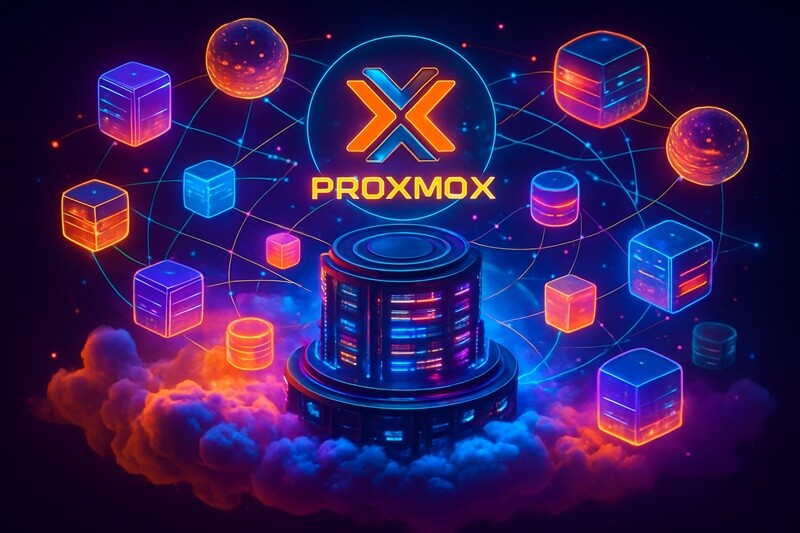In today’s IT landscape, virtualisation is a cornerstone of modern infrastructure. Businesses seek solutions that are cost-effective, scalable, and easy to manage. Proxmox Virtual Environment (Proxmox VE) is one such platform, offering a powerful open-source solution for managing virtual machines (VMs) and containers in a unified interface.
Introduction to Proxmox VE
- Proxmox VE is a complete open-source platform for enterprise virtualization, allowing users to manage virtual machines, Linux containers, and software-defined storage in a unified interface.
- It offers a cost-effective alternative to proprietary solutions, providing key benefits such as flexibility, scalability, and high availability.
- Proxmox VE supports two virtualization technologies: Kernel-Based Virtual Machine (KVM hypervisor) for full virtualization and Linux Containers (LXC) for lightweight container virtualization.
- The platform is built on Debian Linux, providing a stable foundation for hosting virtual machines and containers.
The Proxmox Virtual Environment Core Features
- Web-Based Management Interface
Proxmox provides a centralised, intuitive web interface for managing VMs, containers, storage, and networking. It also supports CLI and REST API for automation. - High Availability (HA) Clustering
Proxmox supports clustering, enabling multiple nodes to work together for redundancy and failover, ensuring minimal downtime. - Integrated Backup and Restore
Built-in tools allow for scheduled reliable backups, snapshots, and disaster recovery planning, reducing the risk of data loss. - Software-Defined Storage
Proxmox integrates with Ceph and ZFS, providing scalable and resilient storage options for enterprise environments. - Software Defined Networking Software-Defined Network (SDN) feature that allows administrators to create virtual zones and virtual networks (VNets), providing a flexible and programmable way to manage networking across clusters. This is particularly useful for multi-tenant environments, complex topologies, and scenarios where network isolation and automation are required.
- Open Source Software and Secure
The Proxmox environment is licensed under GNU AGPLv3, Proxmox guarantees transparency, security, and community-driven development.
Benefits of Proxmox
- Cost-Effective: Free to use with optional paid support, making it ideal for businesses of all sizes.
- Flexibility: Supports both VMs and containers, giving administrators more deployment options.
- Scalability: Easily add nodes to a cluster as your infrastructure grows.
- Performance: Near-native performance for VMs thanks to KVM technology.
Use Cases for Proxmox Virtual Environment
- Data Centres: Consolidate workloads and reduce hardware costs.
- Development Environments: Quickly spin up isolated test environments.
- Hosting Providers: Offer virtual private servers (VPS) and container hosting services.
Building a Private Cloud with Proxmox
- Proxmox VE enables users to build a private cloud – virtualized environment, optimizing existing resources such as physical hardware and licenses all whilst, minimizing expense.
- It provides enterprise-class features for virtualization, including support for multiple nodes, high availability clustering, and disaster recovery.
- Proxmox VE supports various storage options, including local storage, Network File System (NFS), and software-defined storage solutions like Ceph.
- The platform offers a single web based interface for easy management of virtual machines, containers, and storage.
- Proxmox offers a dedicated backup appliance, which delivers efficient, deduplicated backups, automated backups at a fraction of the cost of other solutions—making it a key benefit for organisations seeking reliable and budget‑friendly data protection.
Installing Proxmox Virtual Environment
Proxmox requires minimal IT infrastructure to get started—often just a single server with modest hardware—making it an accessible and cost‑effective choice for building a small virtualisation setup.
- Installing Proxmox virtual environment requires a physical server with Intel or AMD 64-bit CPUs and virtualization support (Intel VT or AMD-V).
- Install Proxmox ve with adequate memory and fast storage for running multiple VM’s and containers.
- The installation process is straightforward, and users can access the Proxmox website for detailed documentation and guidance.
- Proxmox VE supports various installation methods, including ISO installation and remote installation via PXE boot.
Creating Virtual Machines in Proxmox
- Proxmox Virtual Environment allows users to easily manage Proxmox VMs and containers, providing a unified interface for creation, configuration, and monitoring.
- Users can create Virtual Machines – VMs with full virtualization using KVM or lightweight container virtualization using LXC.
- Proxmox VE supports various operating systems, including Windows and Linux, and provides tools for importing and exporting VMs.
- The Proxmox environment offers features like PCI passthrough, Virtual TPM, and GPU allocation, enabling users to customize their VMs and Proxmox workloads.
High Availability HA in Proxmox
- Proxmox VE provides high availability (HA) clustering, ensuring continuous operation of VMs and containers, for critical workloads even in the event of hardware failure.
- The platform supports multiple nodes, allowing users to create a cluster and configure high availability settings.
- Proxmox VE offers automatic failover and migration of virtual machines to healthy nodes, minimizing downtime and ensuring business continuity.
- The platform supports various fencing methods, including IPMI, SSH, and Dell DRAC, to ensure node isolation and prevent split-brain scenarios.
Disaster Recovery with Proxmox
- Proxmox Virtual Environment provides features for disaster recovery, including backup and restore, snapshots, and replication.
- The platform supports various backup strategies, including incremental backups, differential backups, and full backups.
- Proxmox VE offers tools for creating and managing backup jobs, including scheduling, retention, and verification.
- The platform supports disaster recovery to remote sites, enabling users to recover data in the event of a disaster.
Proxmox Backup Server
- Proxmox Virtual Environment includes a built-in backup server, providing a centralized solution for backing up VMs, , Linux containers – lxc and critical data.
- The Proxmox Backup Server supports incremental backups, reducing storage needs and minimizing backup windows.
- The platform offers features like deduplication, compression, and encryption, ensuring efficient and secure backups.
- Proxmox VE supports various storage options for backups, including local storage, NFS, and Ceph.
Backup Best Practices for Proxmox
- Proxmox VE recommends following best practices for backups, including regular recovery testing and verification.
- The platform supports various backup strategies, including the 3-2-1 rule (three copies, two media types, one offsite).
- Proxmox VE offers features like backup scheduling, retention, and rotation, enabling users to create a robust backup policy.
- The platform supports integration with third-party backup solutions, providing users with additional options for data protection.
Enterprise Features in Proxmox from an Single Platform.
- The Proxmox Virtual Environment offers various enterprise grade features on a single platform – including HA clustering, disaster recovery, and backup and restore.
- The platform supports multiple nodes, enabling users to create a scalable and resilient virtual infrastructure.
- Proxmox VE provides features like role-based access control, two-factor authentication, and auditing, ensuring secure and compliant virtualization.
- The platform supports various networking options, including VLANs, bridges, and bonding, enabling users to create a customized network infrastructure and networking functionality.
Proxmox Users and Community
- Proxmox VE has a large and active community, providing users with resources, documentation, and support.
- The platform offers various community-driven projects, including plugins, templates, and tools, extending its functionality.
- Proxmox VE supports user forums, mailing lists, and social media channels, enabling users to connect, share knowledge, and get help.
- The platform provides a wiki and documentation, offering extensive information on installation, configuration, and troubleshooting.
Security Considerations for Proxmox
- The Proxmox Virtual Environment provides various security features, including role-based access control, two-factor authentication, and encryption.
- The platform supports secure boot, ensuring that only authorized operating systems can boot on the hardware.
- Proxmox VE offers features like firewall configuration, network segmentation, and access control lists, enabling users to create a secure network infrastructure.
- The platform supports regular security updates and patches, ensuring that users have the latest security fixes and features.
Troubleshooting Proxmox Issues
PIP is an authorised Proxmox partner, providing end-to-end premium technical support service for the platform—from deployment and configuration to ongoing maintenance and troubleshooting.
- Proxmox VE provides various tools for troubleshooting, including logs, system reports, and performance monitoring.
- The platform supports remote access, enabling users to troubleshoot issues from anywhere.
- Proxmox VE offers features like debugging, tracing, and profiling, enabling users to identify and fix issues.
- The platform provides a knowledge base, wiki, and community forums, offering extensive information and support for troubleshooting.
Migrating to Proxmox Virtual Environment
PIP are specialists in all major hypervisors and can provide a complete, tailored quote to migrate your workloads from any virtualisation platform to Proxmox—or work alongside your team to guide and support your own migration process.
- Proxmox VE provides various tools and features for migrating from other virtualization platforms, including VMware, Hyper-V, and Xen.
- The platform supports import and export of VM’s, enabling users to migrate existing workloads.
- Proxmox VE offers features like P2V (physical-to-virtual) and V2V (virtual-to-virtual) migration, enabling users to migrate physical servers and VM’s, ensuring data integrity.
- The platform supports various migration methods, including online and offline migration, minimizing downtime and ensuring business continuity.
Proxmox vs. Other Virtualization Solutions
- Proxmox VE competes with other virtualization solutions, including VMware, Hyper-V, and Xen.
- The platform offers various advantages, including cost-effectiveness, flexibility, and HA.
- Proxmox VE supports various features, including software-defined storage, networking, and security, enabling users to create a comprehensive virtual infrastructure.
- The platform provides a unified interface for managing virtual machines, containers, and storage, simplifying administration and reducing complexity.
Creating a Proxmox Cluster
- Proxmox VE enables users to create a cluster, providing HA and scalability for virtual machines and containers.
- The platform supports various cluster configurations, including single-node, multi-node, and distributed clusters.
- Proxmox VE offers features like cluster management, node management, and resource allocation, enabling users to create a customized cluster infrastructure.
- The platform supports various storage options, including shared storage, local storage, and software defined storage.
Advanced Proxmox Features
- Proxmox VE provides various advanced features, including software-defined storage, networking, and security.
- The platform supports various storage options, including Ceph, Gluster, and ZFS, enabling users to create a comprehensive storage infrastructure.
- Proxmox VE offers features like network virtualization, including VLANs, bridges, and bonding, enabling users to create a customized network infrastructure.
- The platform supports various security features, including role-based access control, two-factor authentication, and encryption, ensuring secure and compliant virtualization.
So what is Proxmox ?
- Proxmox VE is a comprehensive open-source platform for enterprise virtualization, providing features like high availability, disaster recovery, and backup and restore with minimal expense.
- The platform supports various virtualization technologies, including KVM and LXC, enabling users to create a customized virtual infrastructure.
- Proxmox VE offers a unified interface for managing virtual machines, containers, and storage, simplifying administration and reducing complexity.
- The platform provides a cost-effective and flexible solution for virtualization, making it an attractive option for businesses of all sizes.
Future Developments and Roadmap
- Proxmox VE has a active development community, providing users with regular updates, new features, and bug fixes.
- The platform supports various roadmap initiatives, including improved high availability, enhanced security, and expanded storage options.
- Proxmox VE offers a transparent development process, enabling users to participate in beta testing, provide feedback, and contribute to the development of new features.
- The platform provides a comprehensive documentation and wiki, ensuring that users have access to extensive information on installation, configuration, and troubleshooting.







